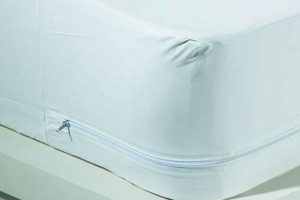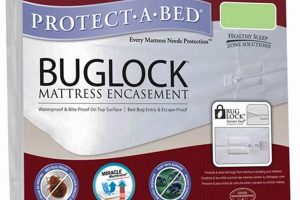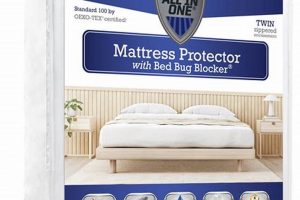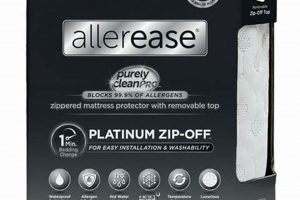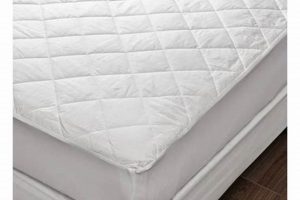A bedding accessory crafted from materials grown without synthetic pesticides, herbicides, or fertilizers, designed to shield a mattress from liquids, stains, allergens, and dust mites, is an essential component for maintaining a clean and healthy sleep environment. An example would be a waterproof barrier made of organic cotton with a polyurethane backing.
The significance of such a product lies in its potential to minimize exposure to harmful chemicals often found in conventional textiles. Benefits extend to individuals with sensitivities or allergies, promoting enhanced sleep quality by creating a cleaner, more breathable sleep surface. Historically, the demand for these items reflects a growing awareness of the impact of conventional agricultural practices on environmental and human health.
The succeeding sections will delve deeper into material composition, certification standards, maintenance procedures, and factors to consider when selecting the appropriate product for individual needs and preferences.
Optimizing the Selection and Use of Bedding Protection
The following points offer guidance on choosing and maintaining protective bedding, ensuring optimal performance and longevity.
Tip 1: Prioritize Certified Materials: Scrutinize labels for certifications such as GOTS (Global Organic Textile Standard) to verify the organic status of the materials used in the product’s construction. This ensures a minimum threshold of organic fiber content and adherence to environmental and social criteria.
Tip 2: Assess Waterproofing Methods: Investigate the waterproofing technology employed. While polyurethane layers offer effective liquid resistance, consider alternatives like TPU (Thermoplastic Polyurethane) for enhanced breathability and reduced chemical content.
Tip 3: Evaluate Allergen Barrier Properties: Confirm that the product effectively blocks allergens and dust mites. Tightly woven fabrics with small pore sizes provide a physical barrier against these common irritants.
Tip 4: Consider Mattress Depth: Verify that the protector’s pocket depth accommodates the thickness of the mattress to ensure a secure and wrinkle-free fit. An ill-fitting protector may compromise its performance and durability.
Tip 5: Establish a Regular Cleaning Schedule: Adhere to the manufacturer’s cleaning instructions. Regular washing, typically in cold water with mild detergent, helps remove allergens, dust mites, and surface stains.
Tip 6: Avoid Harsh Chemicals: Refrain from using bleach or fabric softeners when laundering the protector, as these can damage the fabric and reduce its effectiveness.
Tip 7: Periodically Inspect for Damage: Regularly examine the protector for tears, punctures, or deterioration. Promptly address any damage to maintain its protective barrier.
Implementing these measures contributes to maximizing the benefits of a bedding protector, safeguarding the mattress and fostering a healthier sleep environment.
The subsequent section will summarize the advantages of these products and offer a final perspective on their role in promoting sleep hygiene.
1. Material Certification
Material certification serves as a crucial verification mechanism for claims related to the composition and processing of organic mattress protectors. It assures consumers that the product meets defined standards for organic content and environmentally sound production practices, moving beyond mere marketing assertions.
- GOTS (Global Organic Textile Standard) Certification
This is the leading global standard for organic textiles, encompassing the entire supply chain from harvesting of raw materials through environmentally and socially responsible manufacturing. A GOTS-certified mattress protector indicates that the fabric contains a minimum percentage of certified organic fibers (typically 95% for “organic” labeled products) and that all processing stages adhere to strict environmental and social criteria. For example, a protector labeled “GOTS organic” signifies adherence to stringent standards impacting dye selection, wastewater treatment, and worker welfare.
- OEKO-TEX Standard 100 Certification
While not specifically an “organic” certification, OEKO-TEX Standard 100 tests for harmful substances in textiles. A mattress protector carrying this certification assures consumers that it has been tested for over 100 potentially harmful chemicals and substances, including formaldehyde, pesticides, and heavy metals, ensuring that it meets human-ecological requirements. For instance, a family with young children might prefer a protector with both GOTS and OEKO-TEX certifications to minimize exposure to allergens and harmful chemicals.
- Content Claim Standard (CCS)
This standard verifies the presence and amount of a specific raw material in a final product. The CCS is not a textile processing standard, but rather a tool to verify the content of a particular material in the final product. CCS provides chain of custody verification to confirm the source of the organic material. CCS certified products ensure traceability and accountability within the supply chain.
- USDA Organic Certification
The USDA organic seal is primarily for food and agricultural products, including raw materials like organic cotton. If a mattress protector claims to use USDA-certified organic cotton, it assures the raw material meets USDA’s rigorous standards for organic farming practices, including soil health, pest control, and prohibited substances. This means the cotton was grown without synthetic pesticides, herbicides, or genetically modified organisms (GMOs).
These material certifications collectively contribute to the integrity and trustworthiness of organic mattress protectors. They provide consumers with credible assurance that the product aligns with their values regarding environmental sustainability, health, and ethical production practices. Without these independent verifications, claims of “organic” or “eco-friendly” may be unsubstantiated.
2. Waterproof Technology
The integration of waterproof technology into the design of an organic mattress protector directly addresses the need to shield the mattress core from liquid intrusion. This is a primary functional requirement, as mattresses are susceptible to damage, staining, and microbial growth when exposed to moisture. The efficacy of the waterproof barrier is therefore critical to prolonging the mattress lifespan and maintaining a hygienic sleep environment. Without this component, an “organic” designation alone offers no protection against spills, accidents, or bodily fluids, rendering the product incomplete in its protective function.
Examples of waterproof technologies used in conjunction with organic materials include the application of a thin layer of Thermoplastic Polyurethane (TPU) backing to organic cotton fabric. TPU is favored for its flexibility, durability, and resistance to liquids, while being considered a safer alternative to PVC (polyvinyl chloride) commonly found in conventional mattress protectors. The lamination process bonds the TPU layer to the organic fabric, creating an impermeable barrier. The quality of this bond is important. Poor quality lamination can cause separation, delamination or make the protector noisy. Another example is the use of tightly woven fabrics that, while not completely waterproof, offer significant water resistance due to their construction. These may be treated with water-repellent finishes that are certified to be free of harmful chemicals.
In summary, waterproof technology is not merely an optional feature but an essential component that enables an organic mattress protector to fulfill its intended purpose. The choice of waterproofing method, its material composition, and its application technique directly affect the product’s performance, durability, and overall contribution to a healthy and protected sleep surface. Challenges remain in identifying waterproofing solutions that are both highly effective and fully aligned with stringent organic and environmental standards; ongoing research is crucial for developing advanced, sustainable alternatives.
3. Allergen Barrier
The term “allergen barrier,” when applied to an organic mattress protector, denotes a specific functional property of the product its ability to impede the passage of common allergens such as dust mites, pet dander, pollen, and mold spores. This is not merely a marketing claim but a critical performance characteristic directly impacting the health and well-being of individuals with allergies or sensitivities. The effectiveness of the allergen barrier is determined by the fabric’s pore size and construction. Tightly woven fabrics, typically with a pore size of 10 microns or less, create a physical barrier that prevents allergens from penetrating the mattress. Without this barrier, the mattress acts as a reservoir for allergens, continuously exposing the sleeper to irritants and potentially exacerbating allergic reactions. The consequence is often disrupted sleep, respiratory issues, and heightened allergy symptoms.
The practical significance of an effective allergen barrier becomes evident in scenarios involving individuals diagnosed with dust mite allergies. Dust mites thrive in mattresses, feeding on dead skin cells. An organic mattress protector equipped with a robust allergen barrier effectively starves the dust mite population by preventing them from reaching their food source within the mattress. This, in turn, reduces the allergen load in the sleep environment, leading to a decrease in allergy symptoms. Furthermore, an effective allergen barrier also protects the mattress from becoming contaminated with allergens brought in from external sources, such as pollen adhering to clothing or pet dander from household animals. The application extends to safeguarding individuals with asthma, where allergen exposure can trigger asthma attacks and respiratory distress.
In summation, the allergen barrier function is an indispensable element of a comprehensive organic mattress protector, converting the item from a merely organic product into a tool for allergy management. While the organic designation addresses concerns about chemical exposure, the allergen barrier actively mitigates exposure to biological allergens, optimizing conditions for a healthier sleep environment. Challenges persist in balancing the need for effective allergen blockage with breathability and comfort; innovation in textile technology is ongoing to address these competing demands. The combination of verified organic materials and proven allergen barrier technology represents a benchmark for bedding products aimed at promoting respiratory health and improved sleep quality.
4. Mattress Fit
Proper mattress fit is a non-negotiable aspect of an organic mattress protector’s performance and utility. A protector that does not conform to the mattress dimensions fails to deliver its intended benefits, regardless of the quality of its organic materials or protective technologies.
- Depth Accommodation
The protector’s pocket depth must precisely match the mattress thickness. An undersized pocket depth results in stretching and potential tearing of the protector, compromising its integrity and voiding warranties. Conversely, an excessively deep pocket leads to bunching and wrinkling, diminishing the protector’s comfort and creating uneven surfaces that disrupt sleep quality. Example: A 14-inch thick mattress requires a protector with a corresponding 14-inch pocket depth; using a protector with a 10-inch pocket depth will stress the material and reduce its effectiveness.
- Surface Area Conformity
The protector’s length and width dimensions must align with the mattress’s length and width measurements. Discrepancies in these dimensions lead to inadequate coverage of the mattress surface, leaving portions vulnerable to spills, stains, and allergen exposure. Example: Using a full-size protector on a queen-size mattress leaves significant areas unprotected, negating the benefits of the organic materials and waterproof features in those uncovered sections.
- Secure Attachment
The protector’s attachment mechanism must securely fasten it to the mattress, preventing slippage and displacement during sleep. Loose or inadequate attachment undermines the protector’s ability to function as a barrier against liquids and allergens. Example: Protectors with elastic straps that are too weak or poorly positioned may detach from the mattress corners during the night, exposing the mattress to potential damage and diminishing the protector’s overall effectiveness.
- Wrinkle Minimization
A well-fitted protector minimizes wrinkles and creases, ensuring a smooth and comfortable sleep surface. Excessive wrinkling not only detracts from sleep quality but also creates potential points of wear and tear, reducing the protector’s lifespan. Example: A protector that is too large or poorly designed may bunch up in the middle, creating uncomfortable pressure points and accelerating material degradation.
These elements of mattress fit are integral to realizing the full potential of an organic mattress protector. A correctly fitted protector provides complete and consistent protection, enhances sleep comfort, and extends the lifespan of both the protector and the underlying mattress. A mismatch between the protector’s dimensions and the mattress size renders the product ineffective, undermining the investment in organic materials and protective features.
5. Cleaning Protocol
The establishment and consistent adherence to a rigorous cleaning protocol are fundamentally intertwined with the sustained performance and hygienic integrity of an organic mattress protector. Neglecting appropriate cleaning practices undermines the benefits derived from the organic materials and specialized features of the product, potentially shortening its lifespan and compromising the sleep environment.
- Frequency of Laundering
Regular laundering intervals, dictated by individual usage patterns and environmental factors, directly impact the buildup of allergens, dust mites, and surface contaminants on the protector. While manufacturer guidelines typically suggest monthly cleaning, more frequent washing may be warranted in households with pets, allergy sufferers, or individuals prone to night sweats. Infrequent washing permits the accumulation of irritants, negating the benefits of the protector’s allergen barrier properties and fostering a breeding ground for dust mites. Conversely, overly frequent washing may accelerate wear and tear, diminishing the fabric’s waterproof capabilities and shortening the product’s lifespan.
- Water Temperature and Detergent Selection
Water temperature and detergent selection influence the effectiveness of soil and stain removal while preserving the integrity of the organic materials and waterproof lining. Cold water washing is generally recommended to prevent shrinkage, color fading, and damage to the waterproof membrane. Harsh detergents containing bleach or optical brighteners should be avoided as they can degrade organic fibers, compromise the waterproofing layer, and leave potentially irritating chemical residues. Opting for a mild, plant-based detergent formulated for delicate fabrics is essential to ensure thorough cleaning without compromising the protector’s material composition or functionality.
- Drying Methods
The method of drying can significantly affect the longevity and performance of an organic mattress protector. High heat settings in conventional dryers can cause shrinkage, warping, and delamination of the waterproof barrier. Air drying or tumble drying on a low heat setting is the preferred approach to minimize these risks. Air drying, while time-consuming, is the gentlest method, allowing the fabric to retain its shape and waterproof qualities. When using a dryer, removing the protector promptly upon completion of the drying cycle prevents overheating and potential damage.
- Stain Removal Techniques
Prompt and appropriate stain removal techniques are crucial to prevent permanent discoloration and maintain the protector’s aesthetic appeal. Addressing stains immediately upon occurrence prevents them from setting into the fabric. Gentle blotting with a clean, damp cloth is often sufficient for removing fresh spills. For more stubborn stains, a diluted solution of mild detergent or a specialized stain remover formulated for organic fabrics can be applied. Vigorous rubbing or the use of harsh chemical solvents should be avoided, as they can damage the organic fibers and compromise the waterproof lining. Thorough rinsing after stain removal is essential to eliminate detergent residues.
In conclusion, adherence to a well-defined cleaning protocol is paramount for optimizing the benefits of an organic mattress protector. These cleaning factors interrelate with the product’s core functions, significantly contributing to the longevity, maintenance, and long-term sleep hygiene. Neglecting cleaning recommendations can reduce the organic material’s benefits, shorten the waterproof nature and increase allergen exposure within the sleep environment, thus undermining the intended value.
Frequently Asked Questions
This section addresses prevalent inquiries and clarifies misconceptions regarding protectors specifically designed for mattresses, utilizing organically sourced materials.
Question 1: Does an organic mattress protector guarantee complete allergen elimination?
An item crafted with organic materials alone does not inherently eliminate all allergens. The effectiveness as an allergen barrier depends on the fabric’s weave density and construction, not solely on the organic nature of the fibers. Seek protectors explicitly labeled and certified for allergen resistance.
Question 2: Are all organic mattress protectors waterproof?
The term “organic” pertains to the material’s origin and production methods, not necessarily to its waterproof capabilities. Waterproofing is achieved through additional treatments or layers, such as TPU films. Verify the product description for waterproof or water-resistant claims and supporting certifications.
Question 3: How often should an organic mattress protector be laundered?
Laundering frequency depends on usage and environmental factors. Generally, monthly washing is advisable to remove accumulated dust mites and allergens. Households with pets or allergy sufferers may require more frequent cleaning. Always adhere to the manufacturer’s care instructions.
Question 4: Can conventional detergents be used to clean an organic mattress protector?
Harsh detergents containing bleach or optical brighteners should be avoided. Opt for mild, plant-based detergents specifically designed for delicate fabrics to prevent damage to the organic fibers and waterproof lining.
Question 5: Does the presence of a GOTS certification guarantee the absence of harmful chemicals?
GOTS certification ensures compliance with stringent environmental and social criteria throughout the textile production process, including restrictions on the use of certain harmful chemicals. However, it does not guarantee the complete absence of all chemicals. OEKO-TEX Standard 100 certification provides additional assurance regarding the limitation of harmful substances.
Question 6: Will an organic mattress protector fit all mattress depths?
Mattress protectors are available in various pocket depths to accommodate different mattress thicknesses. Verify the protector’s specifications to ensure compatibility with the mattress depth. An improperly fitted protector may compromise its performance and durability.
The considerations outlined above provide clarity on vital components for those seeking a sleep accessory, while preserving hygiene and promoting overall sleep quality.
The subsequent discussion will summarize the advantages of an organic mattress protector and offer final guidance on their use.
Organic Mattress Protector
The preceding analysis has presented a detailed examination of the organic mattress protector, encompassing its material composition, certifications, protective technologies, and essential maintenance protocols. Key considerations include the verification of organic claims through certifications like GOTS, the implementation of effective waterproofing solutions such as TPU linings, and the presence of a tightly woven fabric designed to impede allergen passage. The importance of proper mattress fit and adherence to a consistent cleaning regimen have also been underscored as critical determinants of product efficacy and longevity. These combined aspects inform the overall performance in safeguarding the sleep surface and promoting a healthier sleep environment.
The decision to acquire an organic mattress protector represents a commitment to minimizing exposure to potentially harmful chemicals and mitigating allergen-related sleep disturbances. While not a panacea, a carefully selected and properly maintained organic mattress protector can contribute significantly to overall sleep hygiene and long-term mattress preservation. Continued research and development in textile technology remain essential to advancing both the protective capabilities and the environmental sustainability of these products.


![Shop Best Tencel Mattress Protector [Eco-Friendly] Organic & Natural Mattress Buyer’s Guide: Non-Toxic Sleep Solutions Shop Best Tencel Mattress Protector [Eco-Friendly] | Organic & Natural Mattress Buyer’s Guide: Non-Toxic Sleep Solutions](https://mattressworldpa.com/wp-content/uploads/2025/07/th-2502-300x200.jpg)
